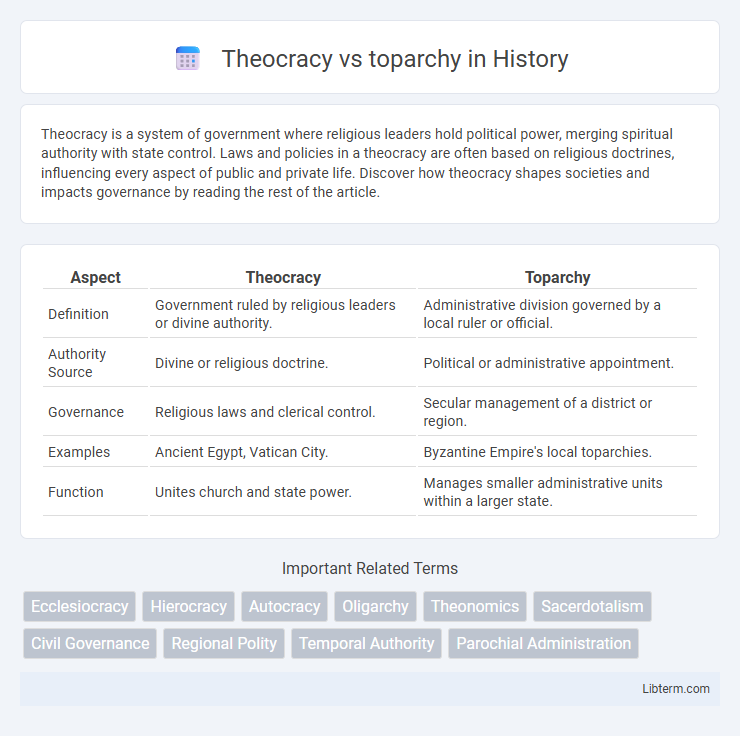Theocracy is a system of government where religious leaders hold political power, merging spiritual authority with state control. Laws and policies in a theocracy are often based on religious doctrines, influencing every aspect of public and private life. Discover how theocracy shapes societies and impacts governance by reading the rest of the article.
Table of Comparison
| Aspect | Theocracy | Toparchy |
|---|---|---|
| Definition | Government ruled by religious leaders or divine authority. | Administrative division governed by a local ruler or official. |
| Authority Source | Divine or religious doctrine. | Political or administrative appointment. |
| Governance | Religious laws and clerical control. | Secular management of a district or region. |
| Examples | Ancient Egypt, Vatican City. | Byzantine Empire's local toparchies. |
| Function | Unites church and state power. | Manages smaller administrative units within a larger state. |
Defining Theocracy and Toparchy
Theocracy is a form of government where religious leaders control political power, and laws are based on religious doctrines, often blending spiritual authority with state governance. Toparchy refers to a minor administrative division or district within a larger political entity, emphasizing local governance and administrative functions rather than religious rule. Theocracy centralizes authority through divine guidance, whereas toparchy focuses on territorial administration within a secular hierarchy.
Historical Origins of Theocracy
Theocracy originated in ancient civilizations such as Egypt and Mesopotamia, where kings were considered divine representatives or deities themselves, establishing a direct link between religious authority and governance. This form of government centralized power in religious leaders who derived legitimacy from their perceived spiritual mandate. In contrast, toparchy was a localized form of administration in ancient Greece, emphasizing decentralized control without inherently combining political power with religious authority.
The Evolution of Toparchy
Toparchy evolved from localized governance systems where small communities exercised self-administration under a broader political framework, contrasting with the centralized religious authority characteristic of theocracy. Historically, toparchy emphasized secular rule by local elites or councils, adapting to social and economic changes without reliance on divine legitimacy. This decentralized political model facilitated greater administrative flexibility and responsiveness compared to the rigid hierarchical structure of theocracy.
Key Features of Theocratic Governance
Theocratic governance is characterized by the integration of religious authority with political power, where rulers are often considered divine or guided by divine principles, ensuring that laws are grounded in religious doctrines. Central to this system is the enforcement of religious laws as state law, with clerical leaders or religious institutions holding significant influence over policy decisions and governance processes. Theocracy typically prioritizes spiritual legitimacy over popular sovereignty, contrasting sharply with toparchy, which features decentralized administration by local rulers or chiefs without necessarily invoking religious authority.
Structural Elements of Toparchies
Toparchies are characterized by decentralized governance structures where authority is localized within distinct territorial units, often led by local rulers or chiefs who exercise both administrative and judicial powers. These entities operate under a loose central authority, allowing for significant autonomy in managing local resources, law enforcement, and taxation. Unlike theocratic systems ruled primarily by religious leaders or divine laws, toparchies emphasize pragmatic, region-specific governance mechanisms rooted in social hierarchies and customary practices.
Case Studies: Theocracies in Practice
Theocracy, exemplified by Iran, enforces religious doctrine as state law, where clerical leadership controls government decisions, contrasting sharply with toparchy, a decentralized tribal governance observed in regions like Somalia. Iran's political system integrates Islamic religious principles into its legal framework, illustrating theocratic governance through institutions such as the Guardian Council. Somalia, in contrast, displays toparchy through localized clan leadership without centralized authority, highlighting the decentralized and variable nature of society-driven governance.
Examples of Toparchic Rule
Toparchy represents a decentralized form of governance where local rulers exercise authority within a defined territory, contrasting with the centralized power of a theocracy. Examples of toparchic rule include the administrative districts in the Byzantine Empire, where toparchs governed regions with delegated authority under the emperor. Similarly, in ancient Egypt, nomes were governed by nomarchs who managed local affairs independently, illustrating the practical application of toparchic administration.
Comparative Analysis: Power Distribution
Theocracy centralizes power in religious authorities who govern based on divine guidance and sacred laws, ensuring a unified ideological control over societal functions. Toparchy distributes power more locally, with autonomous leaders managing smaller districts under a broader political framework, allowing for regional diversity in governance. This comparative analysis highlights the rigid, centralized authority in theocratic systems versus the decentralized, modular power structure characteristic of toparchies.
Societal Impact and Public Participation
Theocracy centralizes authority in religious leaders, significantly limiting public participation by subordinating societal laws to divine rule, which can suppress diverse viewpoints and restrict individual freedoms. Toparchy distributes power across localized, often secular administrations, fostering greater public involvement and adaptability to community needs through decentralized governance. The societal impact of theocracy often results in rigid social structures, whereas toparchy promotes inclusive decision-making and flexible social dynamics.
Contemporary Relevance and Future Trends
Theocracy, characterized by governance based on religious authority, continues to shape political systems in countries like Iran and Vatican City, influencing law and societal norms. Toparchy, a more localized administrative structure, gains relevance in decentralized governance models and smart city initiatives, promoting community-focused management. Emerging trends suggest future hybrid frameworks integrating theocratic principles with toparchic decentralization to balance religious influence and local autonomy worldwide.
Theocracy Infographic

 libterm.com
libterm.com